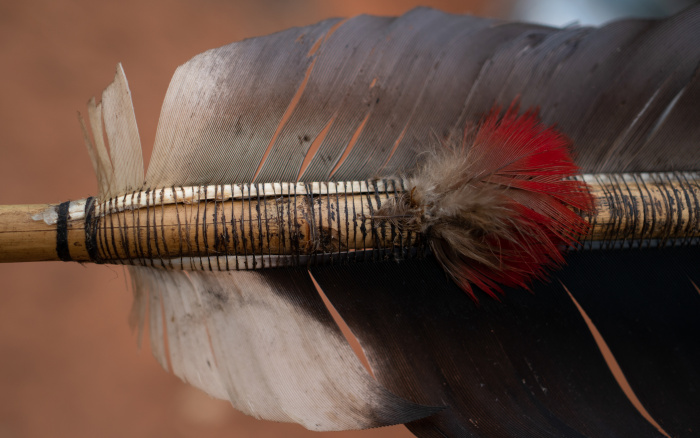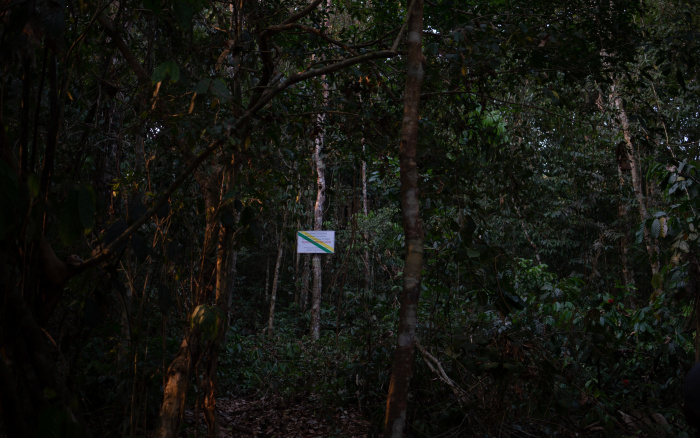Você está na versão anterior do website do ISA
Atenção
Essa é a versão antiga do site do ISA que ficou no ar até março de 2022. As informações institucionais aqui contidas podem estar desatualizadas. Acesse https://www.socioambiental.org para a versão atual.
In the forest, isolated indigenous peoples are surviving in the grip of fires, violence and the pandemic
Thursday, 14 de January de 2021 
Watch the video:
Threatened and Unprotected
Vale do Javari*
Esta notícia está associada ao Programa:
2020 data on invasions and deforestation has alarmed indigenists, who are calling on the State to strengthen protection of indigenous lands
A rare attack in the Uru-Eu-Wau-Wau Indigenous Land ended the life of one of Brazil’s greatest sertanistas, Rieli Franciscato, in September this year. The arrow that struck Rieli was shot by an isolated indigenous person who lives in the territory. Under the classification of the National Indian Foundation (FUNAI), their presence is a confirmed record, proven by expeditions and documentation.
The episode is unusual and points to an extreme situation within the forest. It is difficult to know what happens in the closed forest, but experts say the shot is the consequence of a conflict, possibly triggered by an invader. The arrow was not for Rieli, who was a defender of indigenous peoples for over 30 years.
In the Linha 6 region of the Uru-Eu-Wau-Wau TI, three illegal miners were seen leaving the forest a few days earlier, according to reports from residents. “The indians were indeed trying to shoot someone”, says Fabrício Amorim, a consultant to the National Human Rights Commission (CNDH), who was investigating the exact circumstances at the place where Rieli died. “A lot of invasions, high levels of deforestation. When it comes to the isolados, things are very much invisible. But they must be under a lot of pressure in there”, he says. He points out that the attack was in a tense area, with invasions on the rise. During the pandemic, between March and November, the Uru-Eu recorded 286 hectares of deforestation.
A similar episode took place at the beginning of the year in the Araribóia (MA) Indigenous Land. An indigenous guajajara, belonging to a contacted people who live on the territory, was shot by an isolated Awá Guajá. The indigenous person, whose clavicle was broken by the arrow, was taken to hospital and survived. According to the Guardians of the Forest group, composed of guajajara indigenous people who protect their own territory from invasions, the shot was also the result of a tense scenario in the forest. “With the intense sharing of the territory, and the Awá and Guajajara hunting on each other’s side, nothing like this ever happened”, says Carlos Travassos, an indigenist who has been working in Araribóia for some years.
The area traditionally occupied by the isolados was invaded by loggers about a month before the episode, at the end of April. The invaders broke through sanitary barriers installed by the Guajajara due to Covid-19, and clashed with the guardians. The guardians were able to expel them in the end, but the damage had been done.
According to Travassos, the Guardians of the Forest believe the attack by the isolados is connected to the logger invasions. It is possible that, as in Uru-Eu-Wau-Wau, there was an episode of violence inside the forest, putting the isolados on alert. “The awá approached the (uninhabited) guajajara village because their region was not peaceful”, explains Travassos. In Araribóia, 292 hectares were deforested from March to November during the months of the pandemic.
Fabrício Amorim carried out a recent survey in the area to ascertain the situation and circumstances of Franciscato’s death in Uru-Eu-Wau-Wau. The survey was a request from the Federal Prosecutor’s Office, which wanted impartial information about the area. Amorim reinforces the thesis that the indigenous people are threatened inside the forest and therefore acted with violence. According to Amorim, Franciscato had no intention of entering the forest for an expedition, and only made a quick survey on the edges of the forest, at the start of the TI, when he was hit.
Watch the video:
Threatened and Unprotected
The lack of enforcement and the dismantling of environmental policies has led to increased deforestation and invasions in TIs, including those with the presence of isolated peoples. It has not stopped with the pandemic: on the contrary, the ‘boiada’ of the Environment Minister Ricardo Salles, who reduced environmental protection and Funai’s own measures, increased pressure on territories.
ISA monitoring in the 15 TIs that have a recorded presence of isolated peoples indicates 48 hectares of deforestation in the Uru-Eu-Wau-Wau TI in November alone. In the northern region of the TI, there is a historical conflict in a settlement called Burareiro, set up by INCRA in the 1980s. In addition, a gang of land grabbers are in operation stealing and selling public lands which should be of exclusive use to the indigenous people. Along with the invasions comes violence. In April this year, Ari Uru-Eu-Wau-Wau was brutally murdered in conflict with the land grabbers.
In the Piripkura TI, where the last two remaining Piripkura indigenous people live, the situation worsens each month. In the last month, 456 hectares were felled, following a process of recent months. Between July and November, an enormous deforested area has been growing, with 1,113 hectares of destroyed forest. The territory, which guarantees the Tamandua and Baita indigenous peoples’ way of life, now has a large clearing in its interior. It is possible that the deforestation is related to a FUNAI Normative Instruction and a law that is in progress in Mato Grosso that releases land regularisation for irregular properties in TIs that have not been homologated, that is, where the demarcation process is still inconclusive. This is the case of the Piripkura TI, delimited by a FUNAI Ordinance.
There is also a change in local environmental and climatic conditions, resulting from deforestation and forest fires, which promotes global warming, dryness of the forest and makes life even more difficult for the isolados. In 2020, the Uru-Eu-Wau-Wau TI region experienced a historic 90-day drought. The arid climate drove the fires, which affected a portion of the territory occupied by the isolados, or which they use for wandering. Data from the American Space Agency (NASA) and verified by ISA indicates that 4,185 hectares of forest burned between August and September in this area alone.
In addition, invasions have limited the area of forest where isolados can circulate. Roberto Ossak, of the Land of Rondonia Pastoral Commission, and who joined some of the expeditions in the area with Rieli himself, believes that this combination may have led the isolados to walk closer to the edges of the territory in search of resources. This is because, according to him, at the centre of the TI, the supply of natural resources has been reduced in recent years.
According to Ossak, this scenario may explain the increasingly frequent appearances of isolados from this group. Last June, for example, a group of isolados appeared near the house of a resident, left a piece of meat and took a chicken and an axe. Rieli himself described it as a normal appearance, in search of tools. Two FUNAI teams visited the area to reassure and appease the residents, aiming to avoid conflicts between the residents and the indigenous people. Another important task is to raise awareness among residents about how to act during these appearances. After this episode, Rieli himself joined an expedition to the forest to monitor this group of isolados. The main concern, at the time, was to prevent the indigenous people from being contaminated by the new coronavirus when they approached residents of the surrounding areas, or even from picking up a tool contaminated with the virus.
The group of isolados which appeared in June was of about 15 people, according to reports from residents, and included elderly people and children. It is probably a different group from the one that shot Rieli in September. The latter group, called Urapariquera, and identified as ‘isolados do Cautário’ by Funai, is a large group of over a hundred people.
This estimate is based on the tracks left by them in the forest after migrations, where the entire group walks together leaving ‘footprints’ - nudging trees to collect honey, fruit, etc. Rieli believed them to be a nomadic group circulating throughout the entire southern extension of the Indigenous Land. During the dry season, they remain in the basin of the Cautário River, where there are more resources.
The Federal Prosecutor’s Office is investigating the situation of the isolados in the TI. It has recommended that FUNAI urgently prepare a contingency plan for the area, enforcement actions, reinforcements of human resources and the reopening of the Cautário Ethno-environmental Protection Base. The base is at a strategic location within the indigenous land, but is inactive due to a lack of human resources. Furthermore, the sanitary barriers provided for in the plan for tackling Covid-19 (the object of ADPF 709) have not yet been implemented.
According to Amorim, the indigenous people remain close to the base. Funai says that it has made three teams available for the area, one fixed at the protection base and two others which circulate in the surrounding area for inspection and raising resident awareness.
Deterioration of the Araribóia TI is even more drastic. Even with the constant action of the Guardians, the TI is a scene of invasions. In addition, the theft of wood year after year has started a process of environmental degradation - a poorer forest, with fewer trees, less diversity, drier and more prone to fires. An ISA study in partnership with the European Commission’s Joint Research Centre shows that 38% of the forest is compromised by the degradation.
Another point is that important tributaries of the rivers which run through Araribóia were left outside the demarcation of the Indigenous Land. The tributaries are rivers which feed the main rivers. The result is that many of the springs have been deforested and turned into farmers’ weirs, large artesian wells for cattle to drink from, which also adds to the problem. This process is silting up the springs. The consequence is that the rivers in Araribóia are dry. “There is a real difficulty in obtaining running water, which frightens the specialists who go on expeditions in the bush” says Travassos. The Awá Guajá however, have their own techniques for obtaining water from water holes (cacimbas) and roots and survive in an increasingly arid way of life. For Travassos, in addition to paralysing the exploitation of wood within the territory, investment in the maintenance and recovery of the forests in the headland areas is necessary in order to reconstitute the ecosystem as a whole. “The settlements established in the surroundings of the TI were sold and became large farms”, he says.
According to ISA’s latest bulletin, deforestation in Araribóia slowed down in November. According to Travassos, this is the result of the work of the Guardians, whose expeditions cover the entire limits. Even so, 24 hectares were deforested in November. During the pandemic, between March and November, the TI had accumulated 292 hectares of deforestation.
Vale do Javari*
Another territory which has put specialists on alert is the Vale do Javari Indigenous Land, in Amazonas. This Indigenous Land has the largest number of records of isolados. There are 16 records, 10 of which are confirmed and 6 under study. Historically, the territory has been invaded by miners, poachers and illegal fishermen. There is also an often non-authorised presence of religious missionaries. Covid-19 arrived in this context, heightening fears. In Javari, indigenous people in regular contact with non-indigenous populations share the territory with isolated groups. According to the local DSEI, there have been 729 cases of coronavirus among contacted indigenous people in the region.
Between December 2018 and October 2019, the Ituí-Itaquaí Base of the Vale do Javari Ethno-Environmental Protection Front (FPEVJ) was attacked eight times by gunmen. On September 6, 2019, the FUNAI agent Maxciel Pereira dos Santos was shot dead in Tabatinga (AM), possibly in retaliation for monitoring actions which had been carried out by the agency to curtail illegal activity in the Vale do Javari TI.
The action of the invaders is linked to the fish, game and turtle trade on the Brazil-Peru-Colombia triple border. In addition, the actions of miners has put the Kanamari, the Tyohom Dyapa, of recent contact, and isolated groups at risk. About 300 mining rafts are operating in the region inhabited by these peoples.
In another region, on the banks of the Itaquaí river, poachers and illegal fishermen wait for nightfall to act. They fish for pirarucu, capture tracajás and game animals like tapir, caititu and queixada. Other species are also targeted by fishermen, such as the tambaqui, pacu and aruanã (marketed as ornamental fish). In January 2017, a joint enforcement operation between FUNAI and the Military Police seized 700 turtles and 150 kg of pirarucu from three canoes, in addition to six rifles. In September 2018, in another operation carried out on the Itaquaí River, 389 tracajás and eight turtles were seized in a single canoe.
In the Ituí River region, isolados have approached the Marubo villages. The risk is huge as there are many Marubo contaminated with Covid-19.
The region comprising the middle Javari river and the middle and lower Curuçá, inhabited by the Kanamari, Matsés, Marubo and isolados, is one of the most vulnerable to invasions by fishermen and poachers in the Vale do Javari Indigenous Land. The invasions occur throughout the year and in all the lakes used by the indigenous people of this region. The invaders are after piracuru, turtles and game. The piracuru is the most valuable.
The vulnerability of the isolated indigenous peoples was already a factor of great concern before the Covid-19 pandemic. The actions of the current federal government, such as the low budgetary execution of indigenist and anti-deforestation agencies, the alteration of infra legal norms, the complete paralysation of the demarcation of indigenous lands and overall the lack of dialogue with indigenous organisations indicate that an unprecedented dismantling of policy and legislation is underway. This scenario has been aggravated by the advance of Covid-19 through indigenous lands in the Amazon, especially those where isolated indigenous peoples live.
Effective action by the Brazilian State to protect isolated peoples should be guided by the 1988 Federal Constitution and the strengthening of management mechanisms of public policies for the protection of those isolated groups. In this sense, it is urgent that the Brazilian State make progress in the regulation of these territories, reinforcing environmental inspection and the functioning of Protection Fronts and Bases.
The Brazilian State is inefficient in the protection of indigenous lands and invaders take advantage of this negligence, appropriating land and mobilising their political forces to legalise their trespassing and illegal activities. FUNAI, in actively working to annul or reduce the dimensions of indigenous lands, does nothing but legitimise environmental crime in these territories.
*Information obtained from Conrado Octavo's report, with data from the Centro de Trabalho Indigenista (CTI), in cooperation between ISA and CTI
Clara Roman
ISA
Imagens:








